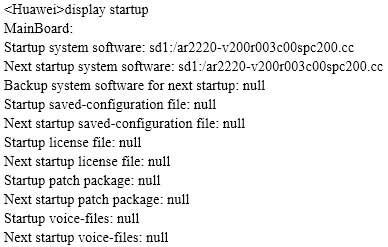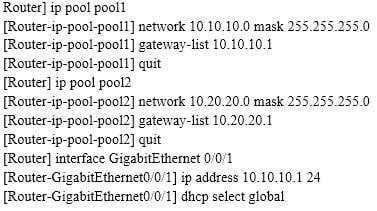H12-211 : HCIA Routing & Switching : Part 05
-
The administrator wishes to change name of the router. Under which view should the administrator be in order to achieve this?
- User-view
- System-view
- Interface-view
- Protocol-view
-
<Huawei> system-view
[Huawei]command-privilege level 3 view user saveRefer to the command output. What is the result of the shown command?
- The command adjusts the save command of a user to privilege level 3.
- The command adjusts the save command in the user view to privilege level 3.
- The command adjusts the user view command privilege level to 3, and saves the configuration.
- The command adjusts the privilege level of a user to 3, and saves the configuration.
-
<Huawei>system-view
[Huawei]history-command max-size 20Refer to the command output. Which statements regarding the shown command are true? (Choose two)
- The command is used to adjust the size of the history command buffer.
- The default value of the history command buffer is 5.
- The command should be configured in the user-interface view.
- Once configured, commands totaling up to 20 bytes can be saved in the buffer.
-
An AR2200 router is required to be reconfigured from scratch. Which steps are needed to achieve this? (Choose all that apply.)
- Reset the saved configuration.
- Clear the current configuration.
- Reboot the AR2200.
- Assign the configuration file to be used at next startup.
-
An administrator has been requested to replace the configuration file of a router in the network. The administrator has been instructed that after logging into the router, he must first permanently erase the current configuration file config.zip from the system.
Which command should he use to achieve this?
- delete /force config.zip
- delete /unreserved config.zip
- reset config.zip
- clear config.zip
-
Which of the following commands can switch a view from the system view to the user view?
- System-view
- Router
- Quit
- User-view
-
Which of the following storage devices are supported by Huawei router? (Select four)
- SDRAM
- NVRAM
- Flash
- Hard Disk
- CF Card
-
Which of the following storage devices is used to store the startup configuration files in a router?
- SDRAM
- NVRAM
- Flash
- BootROM
-
<Huawei>reset saved-configuration
Warning: The action will delete the saved configuration in the device.
The configuration will be erased to reconfigure. Continue? [Y/N]:Refer to the configuration output. Which of the following statements are true? (Select two answers)
- A user should enter ‘Y’ when wishing to clear the saved configuration file.
- The saved-configuration file that the device starts with can be erased.
- The saved-configuration will be deleted after typing N
- The saved-configuration file will be replaced with the current-configuration.
-
When a router is powered on, the router reads the configuration file saved in the default save directory to get itself initialized. If the configuration file does not exist in the default save directory, what does the router use to initialize itself?
- New configuration file
- Initial configuration file
- Default parameters
- Current configuration file
-
Refer to the display output. Which statement is false?

H12-211 HCIA Routing & Switching Part 05 Q11 018 - The current configuration file has not been saved.
- The current startup system software is ar2220-v200r003c00spc200.cc
- The next startup system software cannot be changed.
- The next startup system software can be changed by using the “startup system software <startup-softwarename>.cc” command.
-
<Huawei>
Warning: Auto-Config is working. Before configuring the device, stop Auto-Config. If you perform configurations when Auto-Config is running, the DHCP, routing, DNS, and VTY configurations will be lost. Do you want to stop Auto-Config? [y/n]:When an administrator first initializes the router, a warning is displayed. Which statement regarding this warning is correct?
- If Auto-Config is required, the administrator should select ‘y’.
- If Auto-Config is not required, the administrator should select ‘n’, for which subsequent configuration of the DHCP server, routing, DNS server and VTY user configuration is lost.
- When a device is started for the first time, the Auto-Config function is active.
- When a device is started for the first time, the Auto-Config function is inactive.
-
An AR2200 router in the company network cannot boot. In order to resolve this, the administrator wishes to update the VRP software.
What should he/she do?
- The administrator should use a console cable to connect the router and host, and directly upgrade the device.
- The administrator should use FTP to transfer the VRP software, by configuring the AR2200 router as an FTP client.
- The administrator should use DHCP to boot the AR2200, and then use the AR2200 router as a TFTP client to download the VRP software from the server.
- The administrator should use the telnet command on the client to remote access the device, and upgrade the VRP software.
-
<Huawei>
Warning: Auto-Config is working. Before configuring the device, stop Auto-Config. If you perform configurations when Auto-Config is running, the DHCP, routing, DNS, and VTY configurations will be lost. Do you want to stop Auto-Config? [y/n]:
Refer to the output. When the administrator first starts the router, a system notice is displayed, however after rebooting this router, the notice disappeared. What is the reason for this? (Choose all that apply.)
- This notice only appears during the very first device startup.
- The administrator has configured the device and saved the configuration, causing the notice to disappear.
- The administrator selected ‘n’ and did not save the configuration.
- The administrator selected ‘y’ and saved the configuration.
-
An end system is unable to communicate with a DHCP server following the startup process.
Which IP address may be used by the client?
- 0.0.0.0
- 127.0.0.1
- 169.254.2.33
- 255.255.255.255
-
Refer to the configuration output. The administrator wishes to configure the DHCP server pool in order to assign an IP address to the customer’s terminal device.

H12-211 HCIA Routing & Switching Part 05 Q16 019 Which command should be included in the configuration to provide the minimal lease period for IP addresses?
- dhcp select relay
- lease day 1
- lease 24
- lease 0
-
A DHCP server has been established in the enterprise network. After the client has obtained an IP address from the DHCP server, the user decided to modify the IP address manually.
In what way may this affect the enterprise network? (Choose two).
- The client may experience an IP address conflict.
- The client may access the network normally.
- The client’s interface connection will shutdown.
- The client will associate with another DHCP server.
-
A DHCP server in the enterprise network is being used to allocated IP addresses to hosts. An administrator discovers however that some hosts are obtaining IP addresses outside of the scope of the DHCP server’s address pool.
What are the possible reasons for this? (Choose three).
- Another DHCP server exists in the network and is allocating IP addresses to hosts that happen to be within a closer proximity than the authorized DHCP server.
- The hosts were unable to discover a DHCP server and therefore generated their own address in the 169.254.0.0 address range.
- The hosts were unable to discover a DHCP server and therefore generated their own address in the 127.254.0.0 address range.
- All addresses from the DHCP pool have been assigned.
-
Refer to the configuration output. Following configuration, a host is connected to the interface Gigabit Ethernet 0/0/1 of the router. Which IP address will the client obtain?

H12-211 HCIA Routing & Switching Part 05 Q19 020 - An IP address from network 10.10.10.0/24 will be assigned.
- An IP address from network 10.20.20.0/24 will be assigned.
- The host will be unable to obtain an IP address.
- An IP address may be assigned from either 10.10.10.0/24 or 10.20.20.0/24.
-
The IP addresses of clients in the network are deployed via a DHCP server. When a host reboots, which message will the host first send to the DHCP server?
- DHCP DISCOVER
- DHCP REQUEST
- DHCP OFFER
- DHCP ACK
Subscribe
0 Comments
Newest